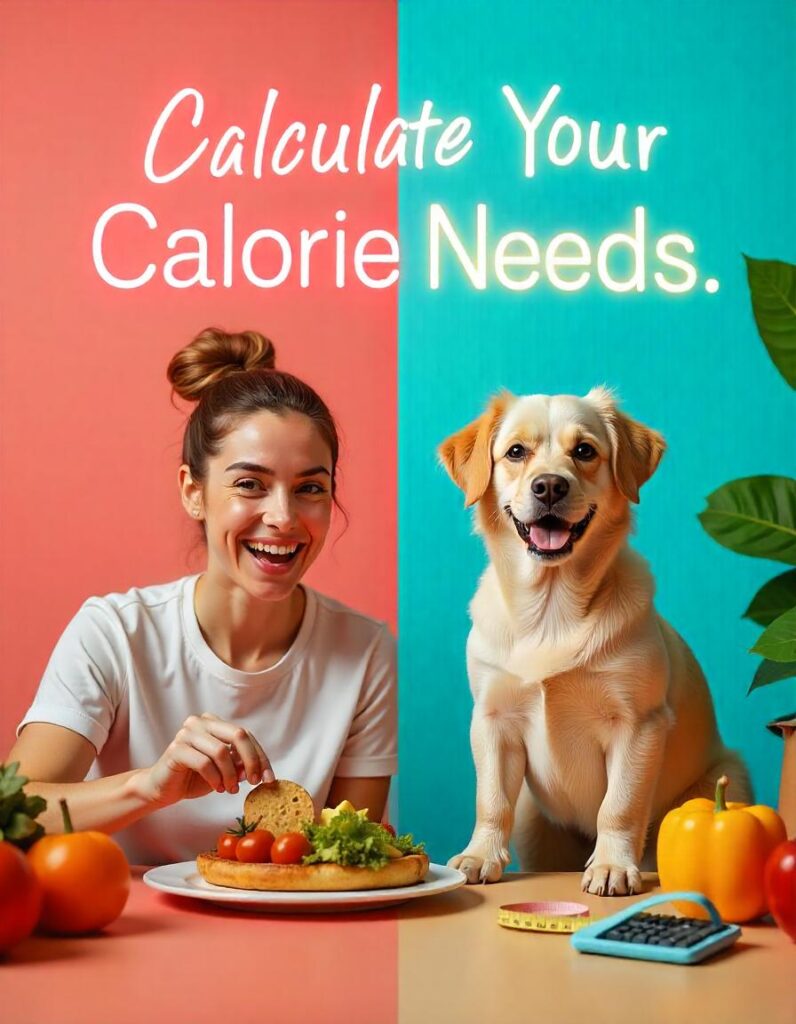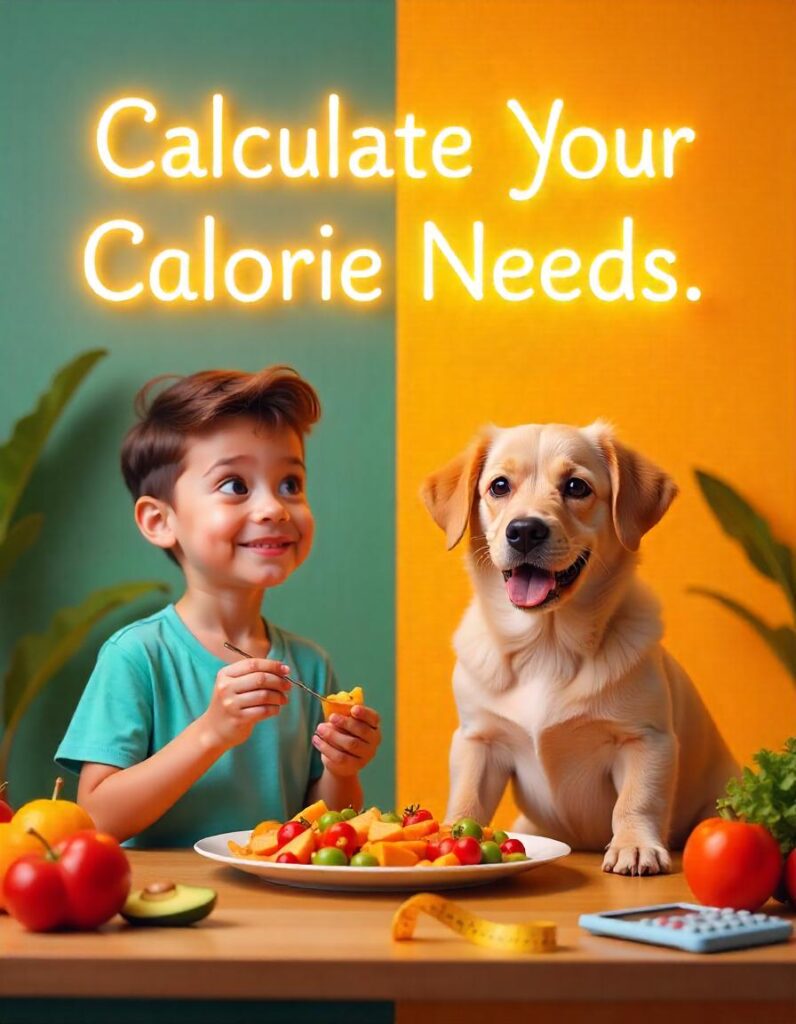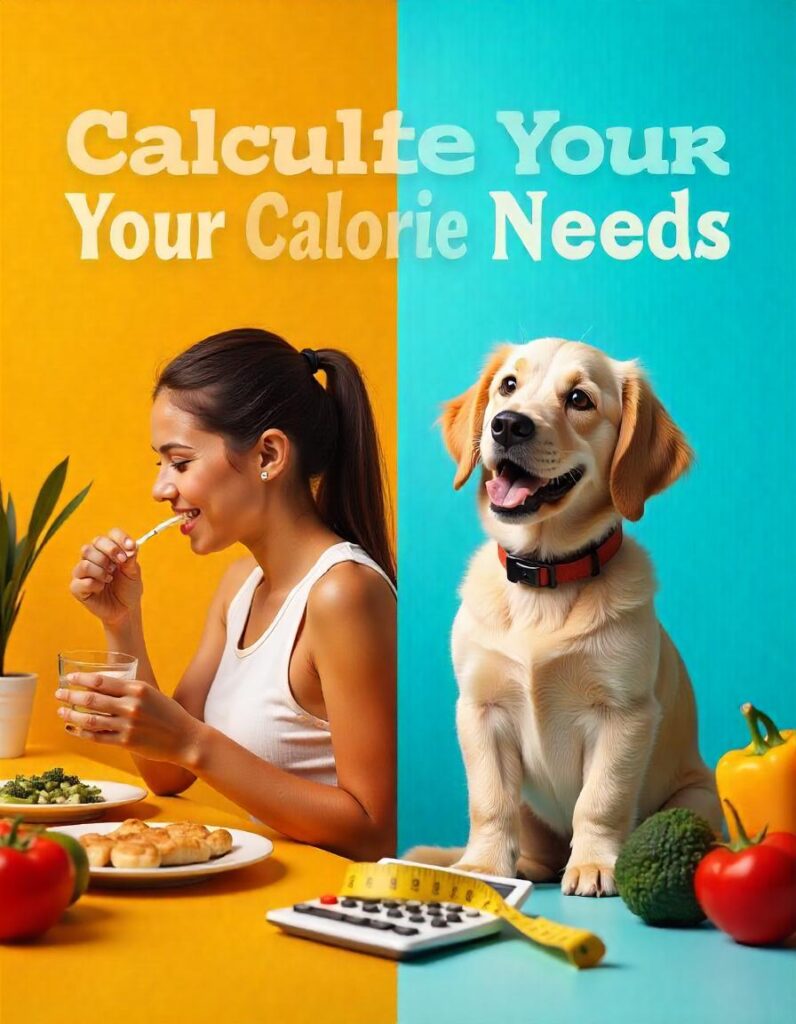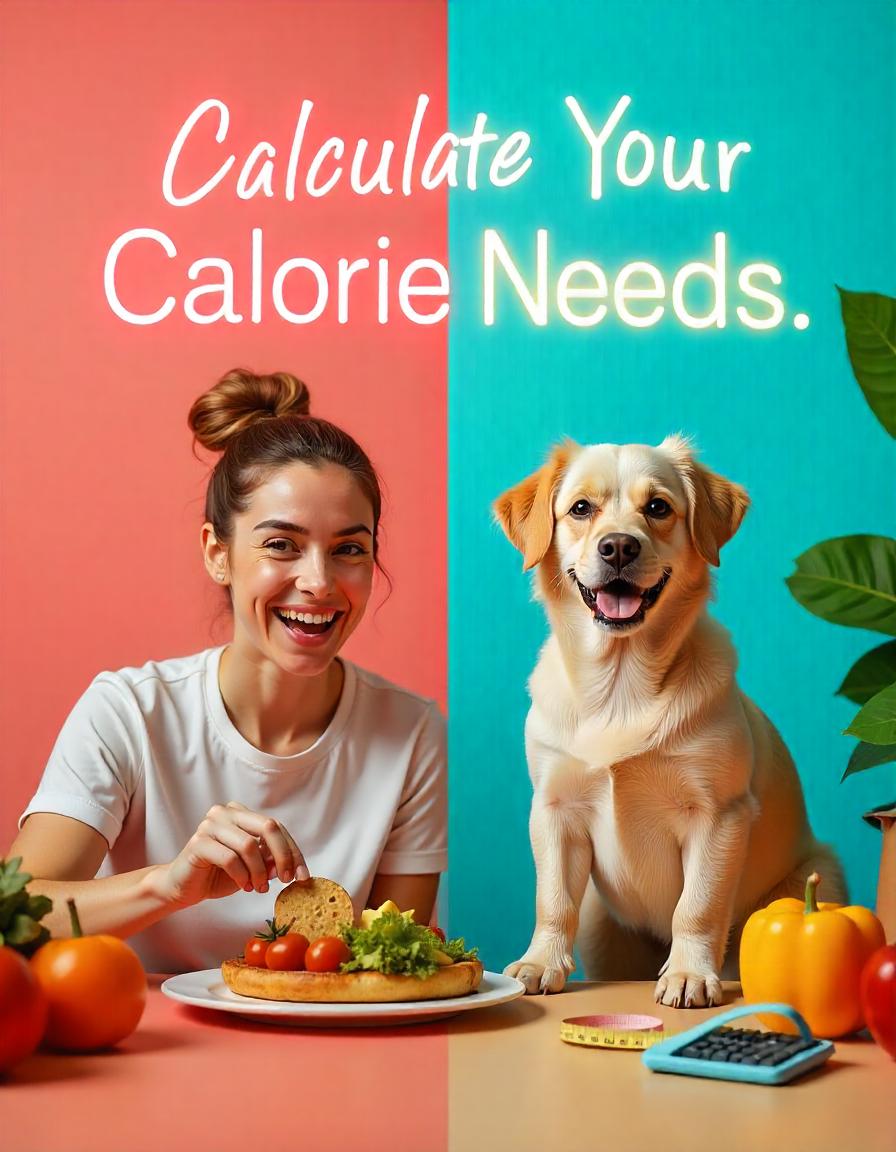Calorie Needs Calculator
Calculate your daily calorie requirements based on your personal information and activity level.
Your Daily Calorie Needs
Tips for Managing Your Calorie Intake
- For weight loss: Aim for a deficit of 300-500 calories per day for steady weight loss.
- For weight gain: Aim for a surplus of 300-500 calories per day for lean muscle growth.
- Track your food intake using apps like MyFitnessPal or Cronometer for better accuracy.
- Combine proper nutrition with regular exercise for optimal results.
- Re-calculate your needs every 3-6 months or after significant weight changes.
Discover how to calculate daily calorie needs for yourself and your dog. Our free calorie needs calculator and expert tips make it easy.
Calorie Needs Calculator: A Complete Guide for Humans & Dogs
Introduction: Why Calorie Counts Matter

We all know that food is fuel, but how much fuel do we actually need? Whether you’re looking to maintain a healthy weight, lose a few pounds, or keep your furry friend in shape, calorie counting plays a huge role in achieving your goals. But here’s the catch – we all have different needs. That’s where the calorie needs calculator comes in handy!
If you’ve ever wondered, “How many calories do I need a day?” or “How many calories does my dog need?” – this guide is for you. Let’s break down calories, what they are, why they matter, and how to figure out the right amount for you and your pet.
What Is a Calorie and Why It Matters
Understanding Calories in Simple Terms
A calorie is a unit of energy. It’s the fuel your body burns to perform all its functions, from breathing to running a marathon. In short, calories are crucial for keeping you alive and active. Whether you’re using energy to think, work out, or simply keep your heart beating, you’re burning calories.
Calories vs. Nutrients: Not the Same Thing
Many people get confused between calories and nutrients. While calories provide energy, nutrients are the substances (like vitamins, minerals, proteins, etc.) that support your body’s functions. You can eat foods with high calories but low nutrients (think junk food), or low-calorie foods that are nutrient-dense (like fruits and vegetables). Both matter, but in different ways.
Calorie Needs for Humans
How Our Body Uses Calories
Your body burns calories for basic survival functions like keeping your heart beating, your brain thinking, and your muscles moving. But it also burns calories to perform more specific tasks, like digesting food and keeping your organs running.
Basal Metabolic Rate (BMR): Your Body’s Idle Burn
Basal Metabolic Rate (BMR) is the amount of energy (calories) your body needs to perform basic functions while at rest. Your BMR accounts for around 60-75% of the total calories you burn in a day. Factors like age, gender, and muscle mass affect your BMR. The higher your muscle mass, the higher your BMR.
Total Daily Energy Expenditure (TDEE): Your Actual Burn
Your Total Daily Energy Expenditure (TDEE) includes your BMR plus the calories burned through physical activities. This is your actual calorie burn in a day. If you’re trying to lose weight, you need to eat fewer calories than your TDEE, and to gain weight, you need to eat more.
What Affects Your TDEE?
A variety of factors affect your TDEE, including:
- Activity level: Are you sedentary, moderately active, or very active?
- Age: Younger people tend to have a higher metabolism.
- Weight and Body Composition: More muscle mass means a higher metabolism.
How to Calculate Your Daily Calorie Needs
Calorie Needs Calculator (Free Tool)
The easiest way to find out how many calories you need is to use an online calorie needs calculator. These calculators ask for basic information like your age, gender, weight, height, and activity level. They provide an estimate of your TDEE and BMR.
Manual Calculation Using Mifflin-St Jeor Formula
If you want a more hands-on approach, you can calculate your calorie needs manually using the Mifflin-St Jeor equation, which is one of the most accurate formulas.
Example Calculation
For men:
- BMR = 10 × weight (kg) + 6.25 × height (cm) – 5 × age (years) + 5
For women:
- BMR = 10 × weight (kg) + 6.25 × height (cm) – 5 × age (years) – 161
Then, multiply your BMR by your activity level:
- Sedentary (little or no exercise): BMR × 1.2
- Lightly active (light exercise or sports 1-3 days/week): BMR × 1.375
- Moderately active (moderate exercise or sports 3-5 days/week): BMR × 1.55
- Very active (hard exercise or sports 6-7 days a week): BMR × 1.725

Factors That Influence Your Calorie Needs
Age, Gender, and Weight
As you age, your metabolism tends to slow down, meaning your calorie needs decrease. Gender also plays a role – men typically have more muscle mass than women, so they tend to burn more calories. Of course, your weight matters, too – the heavier you are, the more calories you’ll burn.
Activity Level and Lifestyle
Your lifestyle affects your calorie burn more than anything else. A person with a desk job will burn far fewer calories than someone who works on their feet all day or exercises regularly.
Special Conditions (Pregnancy, Illness, etc.)
Certain conditions can increase or decrease your calorie needs. Pregnancy, for example, increases your calorie needs, while illnesses or metabolic disorders might decrease them.
Weight Goals and Calories
Calories to Lose Weight
To lose weight, you need to eat fewer calories than your body burns. This is known as a calorie deficit. A safe and sustainable calorie deficit is typically around 500 calories per day, which leads to about 1 pound of weight loss per week.
Calories to Gain Weight
If you’re trying to gain weight, you need to eat more calories than you burn. This is called a calorie surplus. Aim for about 250-500 extra calories per day, depending on your weight goals.
Calories to Maintain Weight
To maintain your current weight, you need to eat about the same number of calories as you burn, meaning your calorie intake should equal your TDEE.
What About Macros? (Protein, Carbs, Fat)
Should You Count Macros or Just Calories?
While calories are the big picture, macros (protein, carbs, and fat) play an important role in achieving your specific goals. If you’re trying to build muscle, you’ll want to eat more protein, while someone focusing on weight loss might emphasize lower carb intake.
Ideal Macro Split Based on Goals
- For weight loss: Higher protein, moderate fats, lower carbs.
- For muscle gain: High protein, moderate carbs, moderate fats.
- For general health: Balanced intake of all three macros.
Common Myths About Calories
“All Calories Are Equal”
Not all calories are created equal. The calories in a sugary soda affect your body differently than those in a piece of whole fruit. Nutrient-dense calories are more beneficial for your overall health.
“Skipping Meals Saves Calories”
Skipping meals might seem like an easy way to cut calories, but it can backfire. It can cause overeating later and negatively affect your metabolism.
Calorie Tracking Tips That Actually Work
Apps, Journals, and Smart Habits
Using apps like MyFitnessPal or a simple food journal can help you keep track of your calorie intake. Just make sure you’re consistent and honest with your entries!
Avoiding Obsession and Burnout
Tracking calories can be helpful, but it’s important not to get obsessed. Focus on healthy habits and use calorie counting as a tool, not a rule.
Calorie Needs Calculator for Dogs
Why Dogs Need Their Own Calorie Math

Dogs have very different calorie needs compared to humans. They need calories to fuel their activities, grow, and maintain their health. But how do you figure out how many calories they need?
Resting Energy Requirement (RER) for Dogs
The Resting Energy Requirement (RER) is the number of calories your dog needs at rest. It’s calculated using the following formula:
- RER = 70 × (body weight in kg)^0.75
Maintenance Energy Requirement (MER)
The Maintenance Energy Requirement (MER) takes your dog’s activity level into account. It’s calculated by multiplying the RER by a factor based on activity:
- Neutered adults: RER × 1.6
- Active adults: RER × 2
- Puppies: RER × 3
Easy Dog Calorie Calculator Tool
Use an online dog calorie needs calculator to input your dog’s age, weight, and activity level. This will provide an estimate of their daily calorie needs.
Dog Calorie Needs by Breed and Weight
Different breeds and sizes of dogs have varying calorie requirements. Larger dogs typically need more calories, but a dog’s age, activity level, and health conditions can influence this as well.
Feeding Your Dog Right
Puppy vs. Adult Dog Calorie Needs
Puppies need more calories for growth, while adult dogs’ calorie needs stabilize. Adjust their intake based on their life stage.
Obese Pets and Portion Control
Obesity is a growing problem in pets. To control weight, monitor their food intake and adjust portion sizes based on their calorie needs.
How Accurate Are Online Calorie Calculators?
When to Trust the Math (and When Not To)
Calorie calculators are helpful, but they provide estimates. They can’t account for every individual factor, like metabolism differences or unique health conditions.
Using Calculators vs. Seeing a Pro
If you’re unsure about your calorie needs or your dog’s, it’s always best to consult with a nutritionist or veterinarian for personalized guidance.
Final Thoughts: Calorie Knowledge Is Power

Whether you’re tracking your own calories or your dog’s, understanding how much energy you need is a crucial step in achieving your health goals. Use a calorie needs calculator, but remember that everyone’s body (and your pet’s) is unique. Combine your knowledge with a balanced diet and regular exercise for the best results.
FAQs
How many calories do I need to lose 1 pound a week?
To lose 1 pound a week, aim for a calorie deficit of around 500 calories per day.
Can I trust free calorie calculator tools?
Free tools can provide a solid estimate, but always remember they’re based on averages and may not account for specific needs.
Do calorie needs change with age?
Yes, as you age, your metabolism tends to slow down, which means your calorie needs decrease over time.
What is the best way to track dog calories?
Use a dog calorie calculator or consult your vet to determine your dog’s daily calorie requirements.
Is counting calories necessary for weight loss?
Counting calories is one of the tools for weight loss, but focusing on whole foods and healthy habits is even more important for long-term success.
